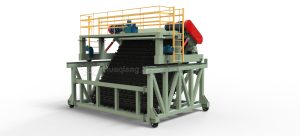For organic fertilizer producers, “slow composting of raw materials and tedious manual compost turning” were long-standing problems—until the advent of the chain compost turner. This seemingly simple device replaces traditional manual labor with mechanized operations. Combined with a suite of compatible auxiliary equipment, it easily bridges key links in organic fertilizer production, effectively solving these challenges.

The most impressive aspect of the chain compost turner is its improved composting efficiency. Once organic materials such as livestock and poultry manure and vegetable straw are mixed and piled according to the desired ratio, the chain-plate compost turner slowly moves along the pile. The chain belt at its base acts like a “flexible shovel,” turning the materials from the bottom upwards.This process not only fully breaks up the raw materials, preventing clumping and uneven fermentation, but also allows for the incorporation of ample air, allowing microorganisms to rapidly reproduce in an aerobic environment. This reduces the composting cycle, which previously took over 40 days, to approximately 20 days. Furthermore, it eliminates the need for manual oversight; a single device can handle thousands of square meters of material yard, significantly reducing labor costs and making it particularly suitable for large-scale production.
Of course, the production of high-quality organic fertilizer requires the assistance of other equipment. Upon incoming raw materials, the straw crusher grinds tough straw and vines into 3-5 cm pieces for easier mixing. During the batching process, the metering feeder acts like a “precision scale.”The ratio of feces, microbial agents, and auxiliary materials is strictly controlled to ensure that the carbon-nitrogen ratio meets the fermentation requirements. After the composting is completed, the vibration screener machine can screen out the stones and uncomposted lumps to ensure the fineness of the raw materials. Finally, if granular fertilizer is to be made, it can be equipped with a granulator to make the finished product easier to store and transport. These devices and the chain plate compost turning machine form an “assembly line operation”, making the organic fertilizer production from raw material processing to finished product delivery efficient and orderly.


